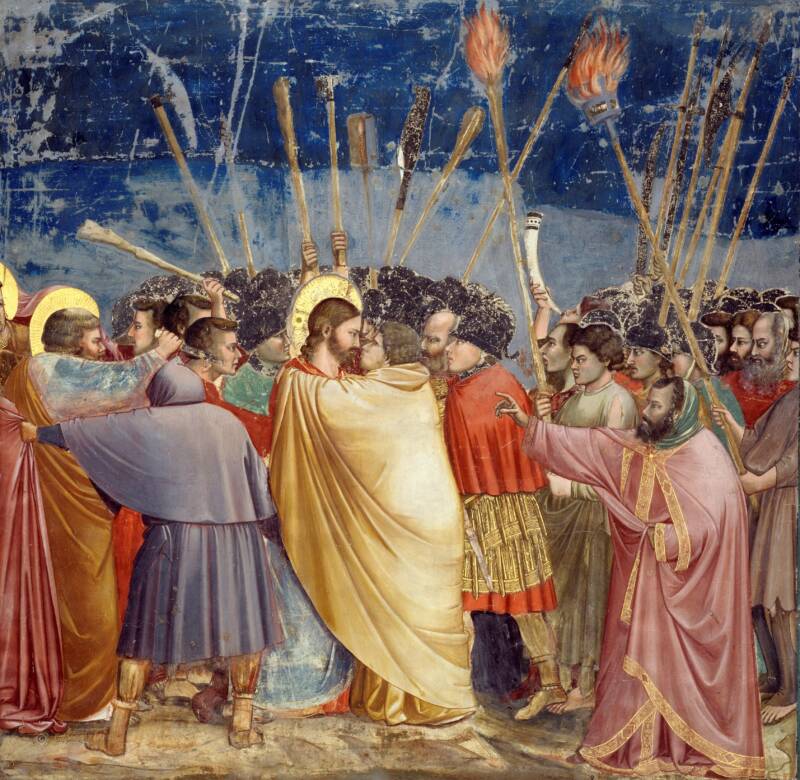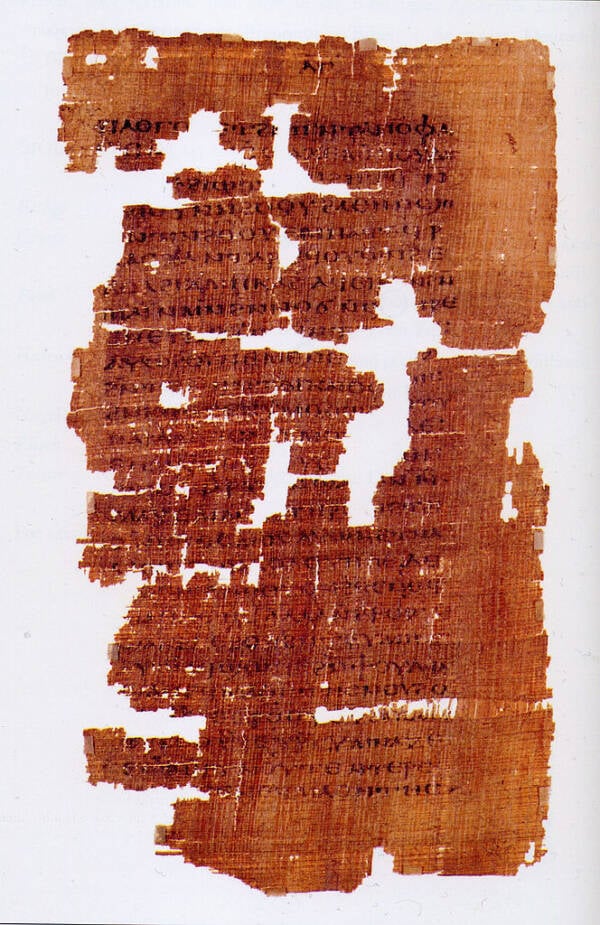Who was Judas Iscariot, a traitor or a faithful disciple? From the writings of St. Paul to the long-lost Gospel of Judas, here are the myths, lies, and historical realities of the real Judas.
To this day, the name “Judas” is synonymous with betrayal. A disciple of Jesus Christ, Judas Iscariot allegedly sold out his master to Roman authorities for 30 pieces of silver.
The mythology around Judas and Jesus is at the foundation of the Christian faith. But historians are not convinced that this biblical story is historically accurate.
For one thing, besides his role as the villain in Christian tradition, written proof of his existence is nowhere else to be found.

Wikimedia CommonsA rendering of Judas Iscariot being paid to betray Jesus.
“No one has succeeded in locating any sources of Judas independent of retellings of the New Testament narratives,” Susan Gubar of Indiana University Bloomington wrote in Judas: A Biography.
“Very few verses are devoted to Judas in the Bible, and they agree only on his being the disciple who gave Jesus over to the Jerusalem authorities.”
As such, any facts about the historical Judas would have been dwarfed by more than 2,000 years of Christian writings that mythologized him as the man who betrayed Jesus. But what is the real story of Judas Iscariot?
The Story Of Judas Iscariot Presented In The Christian Tradition

Wikimedia CommonsAccording to the New Testament, Judas identifies Jesus to the Romans by kissing him. An ancient Egyptian text suggests he did this because Jesus was known to “shape-shift” which made him difficult to distinguish.
The Gospels of Mark, Matthew, Luke, and John, and the Acts of the Apostles (also called the “Book of Acts”) all tell the tale of Judas Iscariot’s betrayal. They do not specify much else about the man himself, i.e., where he was born, where he died, or who his family was. But all accounts agree that Judas, once a trusted follower of Jesus’, for some reason or other turned Jesus over to the authorities in exchange for a cash reward.
According to Matthew, 26:14 and 27, Judas agreed to turn Jesus over to the Roman government for 30 pieces of silver. He was to point out Jesus to the Roman authorities by kissing him. The four Gospels don’t explain why exactly Judas had to kiss Jesus in order to identify him, but a 1,200-year-old Egyptian text translated in 2013 suggests he had to do so because Jesus was known to “shape-shift” and was therefore difficult to distinguish.
Additionally, the Gospel of John states that Jesus already knew that Iscariot was meant to betray him and approached the apostle before the last supper saying, “What you are about to do, do quickly.”
All four Gospels describe Judas as some form of evil. Even his surname, “Iscariot,” is viewed by some historians as a bastardization of the Latin word “sicarius,” meaning “murderer.”
By some accounts, Judas was overcome with the spirit of the Devil, in others, he was already known to be a duplicitous man by nature. According to John, though Judas was the treasurer of the apostles, he was also known to be a thief, and “as keeper of the money bag, he used to help himself to what was put into it.”

Getty ImagesAll four Gospels claim Judas Iscariot committed suicide shortly after he turned Jesus over. How he did so varies, by one account he hangs himself, and by another, his intestines pop out of his body.
But Iscariot was nonetheless a trusted apostle for some reason. Even Jesus’ most prominent followers, like Matthias, acknowledged that Judas “was one of our number and shared in our ministry.” Indeed, Judas must have felt some kinship for his master, as after he turned Jesus over to the authorities, as it’s written in Matthew, he was so overcome with guilt that he abandoned the cash reward and hanged himself.
According to the Acts of the Apostles, Judas’ suicide was even more pathetic, “with the payment he received for his wickedness, Judas bought a field; there he fell headlong, his body burst open and all his intestines spilled out. Everyone in Jerusalem heard about this, so they called that field in their language Akeldama, that is, ‘field of blood.'”
So, what would have brought Judas Iscariot to have betrayed his master in the first place?
Alternative Translations And Theories About Judas
It could have been that Judas did not betray Jesus at all and that the Bible misinterpreted the meaning behind him identifying Jesus to authorities. Some historians have posited that a faction of radical Jews had actually hoped to use Jesus’ influence as a means of confronting their foreign oppressors, the Romans, but that confrontation had gone horribly awry.

PHAS/Universal Images Group via Getty ImagesJudas Iscariot is paid 30 silver coins for handing Jesus over to Roman authorities.
Judas’ surname could also have meant that he was a part of a violent Jewish fringe group called the “Sicarii,” who themselves were a part of the radical movement of Zealots. The Zealots were sort of like political assassins and reportedly carried small daggers or “sica” underneath their garments to knife opponents in the street. Indeed, Jesus is said even in the Bible to have associated with known Zealots, like Simon Zelotes.
The Zealots were in a revolt against the Romans, who had conquered Israel, and may have seen in Jesus an opportunity to overthrow their oppressors. As first-century Romano-Jewish historian Josephus wrote, “When they [the Zealots] saw his [Jesus’] ability to do whatever he wished by word, they told him that they wanted him to enter the City, destroy the Roman troops, and make himself king, but he took no notice.”
As an apolitical, religious leader, Jesus apparently had no desire to lead the charge of a radical Jewish group. The Zealots had hoped to oppose the Romans united under a messiah, which they thought Jesus could be. In order to determine whether or not he was a true messiah, the Zealots needed to put Jesus to trial. In the Greek version of the Bible, the verb used to describe Judas’ confrontation with Jesus at the last supper is paradidomei, which translates to “handed him over.”

Museu Nacional de Belas Artes/Wikimedia CommonsJudas casts aside his money in regret. Painting by José Ferraz de Almeida Júnior. 1880.
Thus, when Judas turned Jesus over to authorities, it wasn’t in betrayal but in a bid to test whether or not the martyr could be the messiah to lead a radical group in a revolt against their foreign oppressors.
Obviously, the Romans did not approve of this potential opponent, whether as a crusader for Christianity or the plight of the Zealots, and so had him killed.
How Judas Iscariot Became Known As The Man Who Betrayed Jesus
The first major Christian writer to discuss Judas’ betrayal of Jesus was theologian Origen of Alexandria.
In his writings, Origen refutes the claims of contemporary theologian Celsus, who had asserted that Judas did not really betray Jesus. Origen writes:
“Will Celsus and his friends now say that those proofs which show that the apostasy of Judas was not a complete apostasy, even after his attempts against his Master, are inventions, and that this alone is true, viz., that one of His disciples betrayed Him; and will they add to the Scriptural account that he betrayed Him also with his whole heart? To act in this spirit of hostility with the same writings, both as to what we are to believe and what we are not to believe, is absurd.”
Later writers doubled down on this narrative and made “betrayal” Judas’ defining characteristic. Often, as Gubar observed, the church fathers associated Judas with the Jewish people as a sort of figurehead in anti-Semitic rhetoric.
For instance, St. Jerome wrote that the Jews’ and Judas’ betrayal were one and the same: “Judas is cursed, that in Judas in particular, was torn asunder by demons — and the [Jewish] people as well.”

Wikimedia CommonsThe writer and Chrsitian scholar Origen of Alexandria.
The likes of Martin Luther propagated these anti-Semitic associations which survive into the modern day. As journalist Jonathan Freedland wrote in The Guardian:
“Now, of course, all the 12 disciples, like Jesus himself, were Jews – yet, as this new exhibition shows, it was Judas who western art chose to depict as the Jew, often with the red hair that marked him out as a betrayer, alongside his mysteriously fair-haired, fair-skinned fellow apostles. The power of the Judas story lives on: his name a byword for traitor, the word Jew and Judas almost indistinguishable in several languages, including German.”
Indeed, some scholars, like April D. DeKonick, professor of Biblical Studies at Rice University, believe the demonization of Judas was used to condemn non-Christians. As DeKonick explained:
“His story was abused for centuries as a justification to commit atrocities against Jews. I wonder if one of the ways that our communal psyche has handled this in recent decades is to try to erase or explain the evil Judas, to remove from him the guilt of Jesus’ death.”
The Gospel Of Judas
In 2006, a so-called “Gospel of Judas,” a “lost” text written in Coptic Egyptian around 300 A.D., was discovered. Found in the 1970s and thought to be a copy and translation of a text dating back to 180 A.D., the Gospel of Judas tells the story of Iscariot not as a villain, but as a loyal servant to Jesus who did only what his master asked.

WolfgangRieger/The Gospel of Judas. Critical Edition/Wikimedia CommonsA page from the Gospel of Judas in its original Coptic script.
By this account, Jesus actually asked Judas to betray him. The Gospel chronicles a secret conversation between Jesus and his varied disciples for “eight days, three days before he celebrated Passover,” during which the martyr berates his apostles for not recognizing his true nature.
Only Judas seems to recognize who Jesus truly is — a divine being from “the immortal aeon of the Barbelo,” a particular heavenly realm. Jesus tells him:
“Separate from them, and I will tell you the mysteries of the kingdom, not so that you will go there, but so that you will be much grieved. For someone else will take your place, so that the twelve [elements] might be complete in their god.”
Jesus then goes on to teach Judas exclusively about the nature of souls and the Second Coming. When Judas sees himself condemned in a vision, Jesus says Judas must betray him in order to achieve Jesus’ goals. “But you will exceed them all,” Jesus tells him, “for you will sacrifice the human being who bears me.”
Unlike in the New Testament, the Gospel of Judas does not seem to reflect a historical reality as much it does an alternative mystical tradition, in line with Gnostic cosmological views present in the ancient Near East at this time. So in antiquity, it appears that not every community regarded Judas as a traitor; in contrast, some apparently thought of him as Jesus’ favorite disciple.
Herb Krosney, who co-wrote The Lost Gospel, told NPR:
“Judas is a different kind of character. He’s the person who is asked to make the ultimate sacrifice. And that sacrifice is to sacrifice the life of Jesus in order that Jesus may attain eternity and immortality. And Judas is the one who enables all of us to help find that inner spark within ourselves.”
The Gospel of Judas is thus just another version of his story, and arguably as valid as the versions put forth in the Four Gospels and Acts. As one among many versions of Jesus’ life circulating around the Mediterranean, this story just did not persist much into modernity.

Wikimedia CommonsIn Islamic tradition, it was Judas who was crucified in Jesus’ stead.
Muslim traditions about Judas also exonerate the apostle and allege that he only betrayed Jesus as a means of helping him to achieve his ultimate goal of martyrdom. Another version suggests that Judas took Jesus’ place on the cross and died in his stead.
Judas Iscariot may have been nothing more than a fictional character in a parable meant to cement the foundation of Christianity as a whole. After all, had he not betrayed Christ, Jesus would not have died and Christianity would not have existed. The many varieties of Judas, it seems, all work to further a given agenda and illustrate how just because it’s written in the Bible, doesn’t make it gospel.
After this look at the history of Judas Iscariot, the man who betrayed Jesus Christ, discover the truth about Jesus’ real name. Then, learn who actually wrote the Bible.






